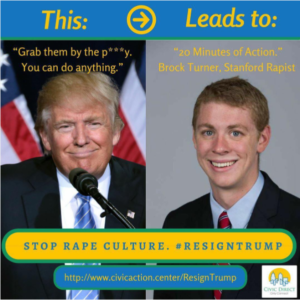 Sometimes I have to write simply because the idea won’t go away. Or perhaps the situation just keeps coming up, all too often. As a therapist I’m overwhelmed with emotion every time I hear or read about the injustice of sexual abuse and more recently the continuance of “rape culture” as perpetrated by Donald Trump and countless others.
Sometimes I have to write simply because the idea won’t go away. Or perhaps the situation just keeps coming up, all too often. As a therapist I’m overwhelmed with emotion every time I hear or read about the injustice of sexual abuse and more recently the continuance of “rape culture” as perpetrated by Donald Trump and countless others.
It kills me every time I hear about the “resilience” of children. When people say this, I don’t think they have the slightest understanding of how trauma works. And I think the danger of believing that people simply bounce back from a wrongdoing is partly what keeps these crimes perpetually in motion. People do not simply bounce back. Bouncing back entails very long, grueling weeks…months… years and years and years of therapy to find a way to piece back together a normal life where one can productively function as a working adult and maintain healthy relationships. And that’s for the lucky ones. The unlucky ones are unable to afford this type of therapy and may not get support. Relationships are negatively impacted, ability to work is affected. Ability to get out of bed is affected. The unlucky ones might turn to things like drug addiction and eating disorders to cope. Sometimes people don’t even know what happened to them, but as Bessel van der Kolk points out, The Body Keeps the Score; even if you can’t consciously remember exactly what happened to you, your body will remember and in some way, shape or form, it comes back to surface.
But being enraged is not enough. Something has to change. Why are there still so many perpetrators out there? What don’t they understand? I know people who think like Donald Trump, in fairly close circles actually… and I’m starting to catch on that they actually assume they are innocent. I believe this mentality is more common than any of us would like to admit. I know people who associate themselves with feminism and still talk like this. Wink, wink. Nudge, nudge. If there are so many people out there who can identify with being inappropriately groped, ridiculed, at the receiving end of derogatory remarks, and flat out attacked – probably you know some of them. And just as likely, you probably know some of the perpetrators as well. They’re out there, just as much as those who have been preyed upon are out there.
So when you consider the 20 minutes that it took for Brock Turner to rock his socks off, please consider the exchange of energy that takes place in a scenario like this. The woman he victimized in this case did not suffer for 20 minutes; it’s highly likely that she will be struggling far longer and in many more difficult and numerous ways than the public eye will ever know. Turner’s slap on the hand is beyond insulting to sexual abuse survivors everywhere.
While I can imagine a number of satisfying revenge fantasies, it’s probably better to come up with something more practical. Here’s my request. Say something. Use your voice. Call these guys out on their bad behavior, label it for what it is. Safety comes first of course, but look for opportunities to offer teaching moments to boys, girls, men, women of all ages. We can’t place the responsibility of speaking up solely on the shoulders of those who have already suffered through the consequences – everyone needs to do this. And if you do feel scared, go to someone safe and tell them – you don’t have to absorb this exchange of energy on your own. While campuses around the country are finally getting wind of the benefits of teaching safe relationships, it’s not enough. We all need to teach people like Turner, who may not have healthy role models, what it means to be a man…to be a decent human being. Think about it, how many times did Trump make lewd comments and no one responded? In the end, maybe this is how people like Turner will be saved too.
As one of my favorite writers on the subject of trauma wrote, “The victim’s greatest contempt is often reserved, not for the perpetrator, but for the passive bystander.”(Judith Herman, Trauma and Recovery, 2015, p92).
Straight Edge band, Fugazi, teaching ’em “what it is to be a man” – they released this in 1989.
Some recent blogs from the Huffington Post:
- The Thing All Women Do That You Don’t Know About
- Moms And Dads: What Your Daughter Hasn’t Told You About Sexual Assault
Copyright 2016 © Rachel Braun, All rights reserved.
Rachel Braun, ATR-BC Art Therapist Philadelphia, PA
Specializing in art therapy groups for women who experience depression, anxiety and eating disorders.


